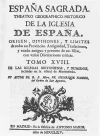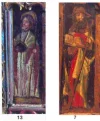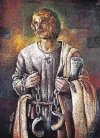twins, cousins, brothers... soul-mates?
TerryB said:
Speculation again I am afraid!
Not speculating; only asking a question... After a good night's sleep and thinking about posting this, your sincerity convinced me that it's OK so here it is:
From:
The Way of Saint James, by Professor Georgiana Goddard King, 1920:
http://www.archive.org/stream/wayofsain ... 1/mode/2up
Volume 3: BOOK FOUR: HOMEWARD: chapters I – III 371-710
chapter VII THE ASIAN GOD 278
The Mortal Twin 334-346
[334] "The Mortal Twin.
[Meat for my black cock
And meat for my red . . .
--George Peele.]
At this point it becomes necessary to consider those apocryphal Acts of the Apostles which brought Pricillian to martyrdom, 1 and with them, the general confusion of mind, in the early centuries of the church, about the name and character of certain of the Apostles. [Romances of the Apostles] There was a time when these pious romances supplied reading to the devout. S. Toribio, whom we have met on the Pass of Rabanal, as he came back from the Holy Land with relics some time before 440, 2 was very active against the Priscillianists and denounced them as reading the Acts of S. Thomas, S. Andrew, and S. John, and with these the Memorials of Apostles, which are not otherwise known. Yet S. Silva of Aquitaine, on her journey sixty years before, 3 had read the Acts of S. Thomas at Edessa, and elsewhere those of S. Tecla, as a matter of course and with edification, [335] precisely like those sentimental travellers who read Le Jardin de Berenice at Aigues Mortes and the Chanson de Roland at Roncevaux.
About certain of the twelve Apostles, and disciples, equally, the situation is not very clear: even the lists in the canonical Gospels do not agree. Some, like SS. Peter and Paul, John and Barnabas, are plain, their names, their burial places: but again, as Michael the Syrian says 4 [A Jacobite Bishop] rather dolefully, there are only three names for six Apostles, which is hard. Some of them are brothers, some of them are commemorated in couples. James was the brother of the Lord, but which James?
"Thy Mother and Thy brethren are without'' -- which are brethren? The genealogy which the Golden Legend offers, it will be remembered, is this: 5
(i) Anna married (a) Joachim, (b) Cleophas, (c) Salomas, and had three daughters all called Mary: (2) Mary Virgin married Joseph and Jesus was her son:
(3) Mary Cleophas married Alphaeus and her children were James Minor, Simon, Jude called [336] Thaddaeus (called also Addai, be it noted), and Joseph Justus [James called Justus: Compostellan Breviary] called Barsabas (whom I know only as a name) :
(4) Mary Salome married Zebedee and her children were James and John called the Sons of Thunder, Boanerges. But the situation was not so clear in earlier centuries nor in the east. Michael the Syrian (1166-1199) says, 6 for instance, that James Zebedee was persecuted at Jerusalem and martyred by a fuller's mallet: with James Alphaeus he brackets Simon the Canaanite called Zelotes and also Nathaniel, who preached in Syria at Aleppo and Mabog (Bombyce, which is Hierapolis) and was martyred at Cyrrhus where his church is. But Theodosius in his treatise On the Topography of the Holy Land 7 says that "Cosmas and Damian lie there at Cyrrhus, not the famous physicians however." The point is apparently that twins lie there and Simon is a twin.
The next Apostle whom Michael the Syrian names is that Thaddaeus whose surname was Lebbaeus, who is Jude the son of James. He was sawn asunder at [337] Berenice, which is Berytus, says Chabot; now Berytus, or Beyrut is the sea-port of Heliopolis. After the list of Apostles he proceeds with the seventy disciples, of whom the first is Addai that preached in Edessa and baptized King Abgar, died and was buried there. Fifteenth comes Jude the brother of James; twenty-sixth Simon the son of Cleophas; twenty-eighth James [… qui el Judas] who was killed with his brother; Mark and Luke figure as forty-third and forty-fourth; fiftieth, John who was thrown to beasts in the theatre of Baalbek! The son of Narses king of Persia who was born during a flight and was brought up in Membig which is Hierapolis, was sent to Edessa on an errand and saw the church built by Addai. 8 From this sample the confusion may be judged.
In Jerusalem the two Apostles called James were for a long time confounded. Theodosius (c. 530) who makes Cleophas one of the pilgrims of Emmaus, says 9:
S. James whom the Lord ordained bishop with his own hand, after the Lord's [338] ascension was cast down from the pinnacle of the Temple and suffered [S. James in Jerusalem] no hurt, but a fuller slew him with a pole on which he used to carry his things and he was buried on Mount Olivet. S. James, S. Zacharias, and S. Simeon were buried in one tomb which S. James had built, he buried the others there and left directions that he should also be laid therein.
Two things are notable here: one that the the fuller's mallet belongs to S. James as [The Mallet God] the instrument of his martyrdom, but it was already the axe of Adad; and the other that the sepulchre with three bodies found at Santiago in the ninth century, existed at Jerusalem in the sixth.
Antoninus Martyr, who was such another as Aymery Picaud, writing about 560-570, [A good companion] mentions the great earthquake at Berytus in which, the Bishop told him, 30,000 persons perished there; this will be what shook down the sanctuary at Heliopolis. He testifies: "On the Mount of Olives rests James the Son of Zebedee, and Cleophas and many bodies of saints."10
[339] And he is trustworthy as Aymery, and like him took his notes on the spot.
John of Wurtzburg (1160-1170) saw the church of S. James in the hands of [" . . . A Gallegan without a head ..."] Armenians, as it is still presumably: "He was beheaded by Herod and his body was placed by his disciples on board a ship at Joppa and carried to Galicia but his head remained in Palestine and is still shown to pilgrims" 11 . . . . An anonymous pilgrim who was in Jerusalem before 1187 saw "the Lord's temple where He was presented and whence He cast out those who bought and sold and from whence James the Lord's brother was cast down." 12 The Citez de Jherusalem, composed after that date, says that there is the church of S. James of Galicia who was the brother of S. John the Evangelist; that at Joppa under a castle in the church of S. Peter is found the cloak of S. James of Galicia on which he crossed the sea; that on a mountain above Acre stands the church of SS. James and John [S. James the Less] where they were born. 13 The buen seynt de Galise is fairly well-defined by the end of the twelfth century.
[340] Burchard of Mount Sion went thither in 1232, and saw the place where S. James was beheaded by Herod Agrippa. 14 But thereafter he is almost forgotten in the east: and James the Less usurps his place. Marino Sanuto (1321) who borrows freely from Burchard, has not a word to tell of the Son of Zebedee, but he relates that near the Virgin's Tomb [--enclosed, but open to the sky--] is the Sepulchre of James the Less, for the Christian buried him here after the Jews had cast him down from the Temple; and elsewhere, that in the Chamber of the Last Supper, S. Matthias was elected, the Holy Ghost descended, the seven deacons were chosen and S. James the Less was ordained Bishop of Jerusalem. 15 Leopold von Suchem, thirty years later, thought that James Minor, the Lord's brother, was martyred by the Jews casting him down from the Temple. 16 After this it seems no more than compensation, if Luke of Tuy makes S. James Major the protomartyr.
His confused account of the Apostles represents the state of Spanish knowledge in the thirteenth century, which was no [341] better than the Syrian. It amounts about to this:
Trajan [he says] built the bridge of Alcantara and allowed the Christians [S. Luke of Tuy] to be persecuted, and Simon Cleophas Bishop of Jerusalem was crucified. S. John died in Ephesus at ninety-nine, when Galen of Pergamo the great doctor flourished. [Then he starts a new paragraph.]
Peter and Paul are buried at Rome; Andrew at Patras, a city of Achaia; James Zebedee in a marble ark and then carried to the farthest province of Spain, Galicia; John at Ephesus, Philip and his daughters at Hierapolis of Asia; Thomas at Calamia a city of India; Matthew in the Parthian mountains; Martial, a disciple of the Apostles, at Limoges; Luke in Bithynia and Mark at Alexandria; James Alphaeus beside the temple at Jerusalem; Thaddaeus, that is Jude, in Beyrout of the Edessenes. Simon Cleophas who is Jude (qui et Judas) bishop after James, was crucified [But compare Abn-Edhari, page 203] at the age of a hundred and twenty Edharif years in Jerusalem and buried there; Titus in Crete; Crescens the eunuch of [342] Candace the queen of Arabia Felix, in Gaul. 17
It is worth noting, perhaps, as an instance of how these confusions come, that the Jerusalem pilgrims went to see the place where Philip baptized the eunuch; now Mgr. Duchesne says 18 that the Latin texts of the Apostolic Catalogues give Macedonia to S. Matthew, Gaul to S. Philip, and Spain to S. James, a few sending S. Matthew to Ethiopia. Philip having been placed in Gaul and then withdrawn, the eunuch becomes his substitute. Two more notes of Mgr. Duchesne's must be remembered: the first, that Mozarabic calendars place the Feast of Santiago [A vegetation spirit] on May-Day 19 ; now Tamayo de Salazar extracts from the Chronicle of Julian Perez the Arch-priest of S. Justa, a statement that S. James the Less was commissioned by S. Peter, acting under orders from the Blessed Virgin, to attend to the interests of the Church and especially of Spain, and his feast fixed for May i. The other is, that he accepts as authentic the Hymn [343] attributed to King Mauregato (783-788) which declares Jacobus Hispaniam: and [--in what sense ?] adds that there seems to be no distinction between the two SS. James. 20
In the Apocryphal Acts of Andrew and Matthias in the City of the Man-Eaters, James and Simon are called the brothers of Jesus the son of Joseph the carpenter. 21
The Acts of Thaddaeus relate how Thaddaeus was a native of Edessa, and after Christ had sent his likeness to King Abgar by Ananias the courier, then, after the Passion and the Resurrection and Ascension, Thaddaeus went to Abgar and instructed and baptized him, as S. Thomas did in the Acts which S. Silva of Aquitaine read there, and ultimately died and was buried at Berytus, a city of Phoenicia by the sea. 22
Taking for a moment East and West together, the case may be stated about as follows:
Thomas was a twin, Didymus; but [--as Rendel Harris shows--] Thomas = Jude, and also Thomas = Thaddaeus (Addai)
Simon + Jude are a pair [344]
James is brother of the Lord; but there are two Jameses
James Major = James Minor and Philip + James are a pair
These all are twins and all are interchangeable.
Philip = Adad at Hierapolis, but
Philip + James Minor = James Major
.*. James Major = Adad, especially at Heliopolis.
It can be further proved. In the Acts of Philip, S. Philip is called the Son of [S. Philip surrogate of S, James] Thunder; 23 he is subject to fits of rage like SS. James and John when they would have called down fire from heaven; 24 he directs the preparation of his mummy in wrappings that would bring it to the shape of the cult-image. 25 But he bears in other ways more likeness to Dionysus, he is accompanied by the leopard and the kid of the [Avatar of Dionysus,] goats, 26 and by wild women, 27 and where his blood falls a vine springs up. 28 Now the minor temple at Heliopolis, as we know today, was dedicated to Dionysus. His companion and sister is Mariamne, who is a disciple of S. James in other legends, [345] and who, by the way, is herself a twin! 29 Rendel Harris has expounded delightfully how S. Thomas is the twin of Christ, and looks just like him, so that Christ on coming into a room is taken for S. Thomas who has just gone out. 30 "And the Lord said to him, I am not Judas who also is Thomas; I am his brother." In the Acts of Philip, when S. Philip is in the rôle of S. James, Christ appears in the likeness [and twin Christ] of S. Philip. 31 Priscillian knew this twin of ol Christ's: "Ait Juda apostolus clamans ille didymus domini". 32 As one of the Sons of Thunder, of course S. James was a twin, and again we have to thank Rendel Harris for all the instances of the twin-child that is the Lightning's child: 33 S. John was the twin brother to S. James, but S. John was otherwise disposed of. He lived to be very old, his place was Ephesus: S. John in Ephesus, S. Peter in Rome, S. James in Compostella, was an idea familiar to the twelfth century in Galicia, and doubtless elsewhere and earlier: so the world was distributed, east and west and in Italy. Therefore S. James must have another twin: and was he not [346] already, in Canonical Scripture, the Brother of the Lord? The mortal twin, the chthonian power [One goes to the underworld], is S. James: the divine, in heaven, is Jesus: but on the baldachin at Compostella S. James ruled.
Eastern Spain was peculiarly liable to influences from the East, and Syrian saints abound at Vich, Tarrasa, and thereabouts, who are often brethren, like SS. Cosmo and Damian, SS. Abdon and Senen. But in Catalan painting [Evidence from Iconography] of the fourteenth and fifteenth century, the twins are enforced, the likeness between S. James Major and his Master Christ is as marked as in the Gloria of Maestro Mateo. In the Last Supper of Solsona S. James in hat and slavey n still looks like Christ; in the Serras' altar piece at S. Cugat the two SS. James are identical, except for attributes. In Borassa's retable of the Poor Clares at Vich, SS. Simon and Jude look precisely like the Veronica which they are presenting to King Abgar; so in the predella, only SS. Thomas and Matthias (= Matthew), so S. James Minor.
[347] The High God. (…)"
---------------------------------
PS: For the record, I'm not speculating or stating anything, just asking questions. I'm not an expert at all in these Elysian fields but a very curious layman (whatever Matron thinks - I also like questions better than answers). This text above is too complicated for me, so I hope some expert could summarize the core of the message for some of us. Again, I can't help feeling that
twin and
brother and
cousin is used here like
soul-mate is these days and that many names and titles represent facets of the same jewel in Georgiana's crown.
PPS: To my big surprise many books in the Notes below can be read full-text-on-line*:
NOTES King Volume III pp 484-486 referring to pp 334-346 (text above)
The Mortal Twin:
1 Babut, Priscillien et la Priscillianisme, p. 130. *10
2 España sagrada, XVI, 39; Babut, op. cit., p. 238. [485] *2 [picture below]
3 S. Silva of Aquitaine, pp. 35, 43: Palestine Pilgrims' Text Society. *1
4 Chabot, Chronique de Michel le Syrien, I, 149. *5
5 Caxton's Golden Legend, V, 97, Nativity of our Lady. *8
6 Chabot, op. cit., I, 148-149.
7 Palestine Pilgrims' Text Society, p. 19, §86.
8 Chabot, op. cit., p. 183.
9 Palestine Pilgrims' Text Society, p. 11. *1
10 Palestine Pilgrims' Text Society, pp. 2, 14.
11 Palestine Pilgrims' Text Society, p. 45.
12 Palestine Pilgrims' Text Society, p. 33.
13 Palestine Pilgrims' Text Society, pp. 5, 33, 43.
14 Palestine Pilgrims' Text Society, p. 78.
15 Palestine Pilgrims' Text Society, p. 42, 46.
16 Palestine Pilgrims' Text Society, p. 100.
17 Hispaniae Illustratae, IV, 34. *7
18 S. Jacques en Galice, pp. 151, 152. *9
19 Id. ibid., p. 166.
20 Id. ibid., p. 153; Dreves, Analecta Hymnica, XXVII, 187. *3
21 Walker, Apocryphal Gospels, Acts, and Revelations, p. 354. *4
22 Id. ibid., pp. 440-443.
23 Id. ibid., pp. 308, 320, 323.
24 Id. ibid., pp. 309, 323.
25 Id. ibid., p. 314.
26 Id. ibid., pp. 314, 328, 329.
27 Id. ibid., p. 305.
28 Id. ibid., p. 315.
29 Id. ibid., pp. 301, 303. [486]
30 Id. ibid., p. 394.
31 Id. ibid., p. 316.
32 Schepss, Corpus Scrip. Eccles. Lat., XVIII, 44. *6
33 Boanerges, passim.
The High God:
* Read full-text-on-line:
*1 http://en.wikipedia.org/wiki/Palestine_ ... xt_Society -
*2 http://es.wikipedia.org/wiki/Espa%C3%B1a_Sagrada –
*3 http://www.archive.org/details/analecta ... 18drevuoft - Analecta Hymnica Medii Aevi (1894) - Author: Dreves, Guido Maria, 1854-1909 -
*4 http://www.archive.org/details/apocryph ... 00walkgoog - Apocryphal Gospels, Acts, and Revelations (1870) Author: Alexander Walker -
*5 http://www.archive.org/details/Chroniqu ... ranslation - Chronique de Michel le Syrien, t. 1 (translation) - Author: Michael the Syrian; Michel le Syrien; J.-B.Chabot -
*6 http://www.archive.org/details/corpussc ... 28wissgoog - Corpus scriptorum ecclesiasticorum Latinorum (1866) Author: Kaiserl. Akademie der Wissenschaften in Wien; Akademie der Wissenschaften in Wien; Österreichische Akademie der Wissenschaften -
*7 http://www.archive.org/details/damianigoesopusc00gi - Damiani a Goes ... Opuscula quae in Hispania illustrata continentur (1791) Author: Góis, Damião de, 1502-1574 -
*8 http://www.archive.org/details/legendaa ... 00butlgoog - Legenda Aurea - Légende Dorée - Golden Legend: A Study of Caxton's Golden Legend with Special ... (1899) Author: Pierce Butler
*9 http://www.archive.org/details/saintjacquesenga00duch - Saint Jacques en Galice (1900) Author: Duchesne, L. (Louis), 1843-1922 -
*10 http://www.persee.fr/web/revues/home/pr ... 2_0000_002 - E.-Ch. Babut. Priscillien et le priscillianisme. Paris, H. Champion, 1909. (Bibliothèque de l'Ecole des Hautes-Etudes, fasc. 169.) -
And…
- http://fr.wikipedia.org/wiki/Priscillianisme - Priscillien, mort à Trèves en 385, est un évêque d'Avila, condamné pour hérésie, et le premier chrétien condamné à mort et exécuté par une autorité chrétienne pour cette raison. Le priscillianisme est une des premières hérésies condamnée par la jeune Église de Rome. Certains la rapprochent des pauliciens. –
- http://publishing.cdlib.org/ucpresseboo ... nd=ucpress - The Making of a Heretic; Gender, Authority, and the Priscillianist Controversy - Virginia Burrus –
- http://www.pilgrimagetoheresy.blogspot.com - http://www.pilgrimagetoheresy.com - PILGRIMAGE TO HERESY, Don't Believe Everything They Tell You, A Novel of the Camino; by TRACY SAUNDERS
- Boanerges - see miscellaneous-topics/topic11158-100.html?sid=70f56c037be6785a2bc41f9aa32b640b#p75449























